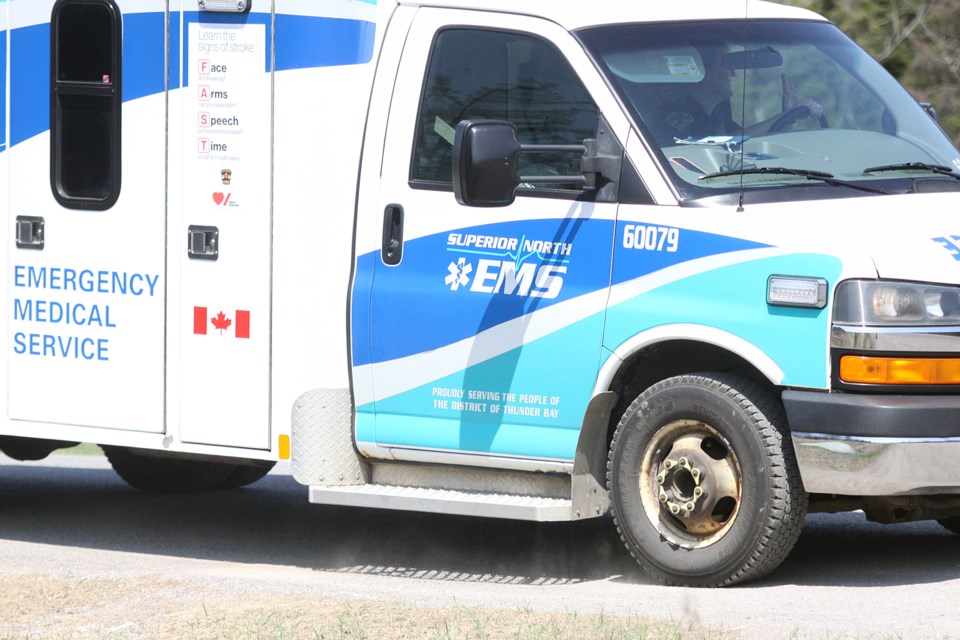THUNDER BAY – A growing number of communities are expressing deep concerns over a new master plan for EMS services in the Thunder Bay District, saying their objections reflect a total lack of proper consultation.
Thunder Bay’s city council voted nonetheless to receive the 10-year plan prepared by Performance Concepts Consulting Monday, though that doesn’t bind the city or Superior North EMS to implement its recommendations.
Several district municipalities and First Nations have now spoken out against the plan, particularly proposals to consolidate four district stations into two (Terrace Bay/Schreiber and Nipigon/Red Rock), and to close another in Beardmore.
The changes are part of a larger strategy to optimize resources in the face of potentially massive demand growth, mostly in Thunder Bay. Calls for service could increase by over 50 per cent by 2030 due to an aging population and increasing willingness to call 9-1-1, consultants have warned.
The municipality of Greenstone was the latest to join the chorus of opposition Monday, presenting a resolution from its own council asking Thunder Bay not to approve the plan in its current form.
“There has been little to no consultation or dialogue with the municipality, community, or area First Nations on the proposal,” the resolution read in part.
“With an admitted lack of consultation, we find it hard to believe we’re valued partners in this plan,” agreed Terrace Bay mayor Jody Davis later in the meeting.
Three Beardmore-area First Nations had harsher words, saying consultation had been “non-existent.”
The concerns were outlined in a letter from Animbiigoo Zaagi’igan Anishinaabek (Lake Nipigon Ojibway), Bingwi Neyaashi Anishinaabek (Sandpoint First Nation), and Biinjitiwaabik Zaaging Anishinaabek (Rocky Bay First Nation).
“Presenting an already prepared report and recommendations at one meeting with multiple First Nations… is not consultation,” they wrote. “If you had met with us, we would have informed you about the importance of the Beardmore EMS Station to our respective memberships, and that saving lives should be a more important principle than saving money.”
Brenda Goodman, a nurse practitioner at the Beardmore clinic, told councillors her small clinic was unequipped to respond to emergency situations without the support of EMS.
“A word that best describes the actions of Superior North EMS is abandonment,” she said.
The removal of the station would leave Beardmore residents facing two-hour waits to reach a hospital, estimated Greenstone councillor Claudette Trottier, thanks to a 170-kilometre round trip from the nearest EMS base.
Performance Concepts president Todd MacDonald stood by the report’s recommendations, saying the process had deliberately relied on data over consultation.
The 12-hour ambulance service stationed in Beardmore was active only three per cent of the time, he said. The station responded to fewer than 10 calls a year requiring “lights and sirens transport,” he added, and only one or two of those were typically in the highest response category.
“Those resources, if they were deployed to a busier area, would be able to deliver relatively more patient benefit,” he said. “That’s the dilemma you face: in an era of finite resources, where and how can we best deploy the resources we have to benefit the highest number of patients in need?”
Beardmore residents wouldn’t be abandoned entirely, he pointed out: the master plan suggests leaving behind a paramedic with a non-ambulance vehicle, who could be based out of the clinic.
“For someone who is ill and requires emergency care, the response on-scene with a paramedic would be relatively quick – not much different than it is now,” MacDonald said.
Transport of the patient would take longer, if needed, he acknowledged.
Schreiber mayor Dave Hamilton found that response unsatisfactory, saying a difference of minutes in emergency response can have life-or-death consequences.
The shift would also bring benefits, however, MacDonald said.
"The expansion in the clinic setting would allow the paramedic stationed there to do more community-based paramedicine and deliver higher value in the community.”
Thunder Bay and the district communities found some common ground over their belief the federal government should provide more support for EMS services in areas that serve high numbers of First Nations patients.
Senior levels of government already fully fund a station in Armstrong, after SNEMS demonstrated First Nations patients made up more than 70 per cent of calls there.
Thunder Bay mayor Bill Mauro and counterparts present at the meeting agreed it should be a priority to advocate for a similar approach in other communities.
Mauro also assured representatives from other communities Monday that voting to receive the master plan did not mean its recommendations would be followed.
City administration is set to report back in April with recommendations on implementing the plan. General manager of emergency services Mark Smith said it would likely take longer than that to assess larger structural changes such as the changes to bases in district communities.
